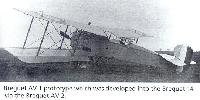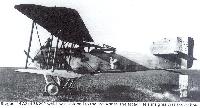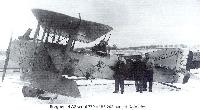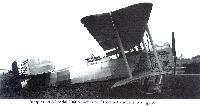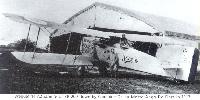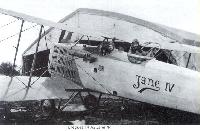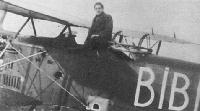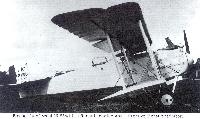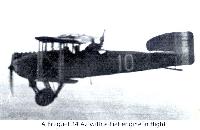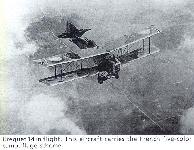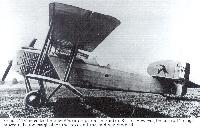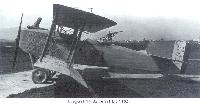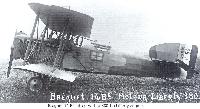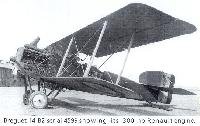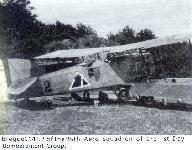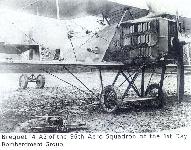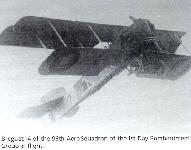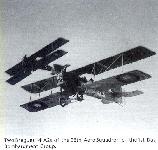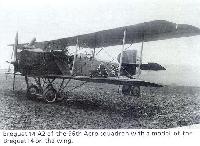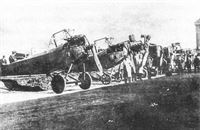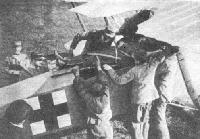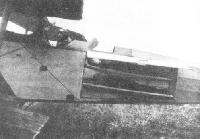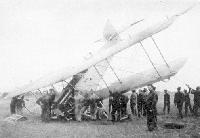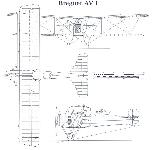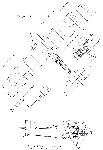
Описание
Страна: Франция
Год: 1917
Фронтовой самолет
Варианты
- Breguet - Br.14 - 1917 - Франция
- Breguet - Br.16 B.N.2 - 1918 - Франция
- Breguet - Br.18 Berline - 1919 - Франция
- В.Кондратьев Самолеты первой мировой войны
- А.Шепс Самолеты Первой мировой войны. Страны Антанты
- J.Davilla, A.Soltan French Aircraft of the First World War (Flying Machines)
- G.Swanborough, P.Bowers United States Military Aircraft Since 1909 (Putnam)
- J.Forsgren Swedish Military Aircraft 1911-1926 (A Centennial Perspective on Great War Airplanes 68)
- Журнал Flight
-
D.Mechin - Oriental Adventures of the French Air force 1914-1918 /Aeronaut/
Breguet 14 A2 no 902, Escadrille 525, Vrbeni, Late 1918.
-
D.Mechin - Oriental Adventures of the French Air force 1914-1918 /Aeronaut/
Breguet 14 A2 no 908 Titine, Escadrille 504, 1918
-
D.Mechin - Oriental Adventures of the French Air force 1914-1918 /Aeronaut/
Breguet 14 (no 908) of the 504 squadron at Gorgop during the summer 1918. The French corps squadrons received some Breguet 14s at the time of the final offensive, which began to replace obsolete Dorand ARs.
-
А.Шепс - Самолеты Первой мировой войны. Страны Антанты
Тактический разведчик Бреге Bre.14 A2 (1917г.)
-
D.Mechin - Foreign Fronts of the French Air Force 1914-1919 /Aeronaut/
Breguet 14 A2 n°9122 of sergent Joseph Pouliquen, escadrille 590, Bratislava 1919.
-
D.Mechin - Oriental Adventures of the French Air force 1914-1918 /Aeronaut/
Breguet 14 A2 (serial unknown), escadrille 509, Negocani, 1918.
-
J.Davilla, A.Soltan - French Aircraft of the First World War /Flying Machines/
Breguet 14 A2 of BR 234.
-
J.Davilla, A.Soltan - French Aircraft of the First World War /Flying Machines/
Breguet 14 A2 of BR 287.
-
D.Mechin - Oriental Adventures of the French Air force 1914-1918 /Aeronaut/
Breguet 14 B2 no 1223 Leon, Escadrille 504, 1918.
-
J.Davilla, A.Soltan - French Aircraft of the First World War /Flying Machines/
Breguet 14 B2 of BR 117.
-
J.Davilla, A.Soltan - French Aircraft of the First World War /Flying Machines/
Breguet 14 B2 of BR 117.
-
J.Davilla, A.Soltan - French Aircraft of the First World War /Flying Machines/
Breguet 14 B2 of BR 108.
-
А.Шепс - Самолеты Первой мировой войны. Страны Антанты
Ночной легкий бомбардировщик Бреге Bre.14 BN2 (1918г.)
-
J.Davilla, A.Soltan - French Aircraft of the First World War /Flying Machines/
Breguet 14 B2 of BR 123.
-
J.Davilla, A.Soltan - French Aircraft of the First World War /Flying Machines/
Breguet 14 B2 of BR 132.
-
J.Davilla, A.Soltan - French Aircraft of the First World War /Flying Machines/
Camouflage pattern of Farman built Breguet 14s (G-1 pattern).
-
А.Шепс - Самолеты Первой мировой войны. Страны Антанты
Легкий бомбардировщик Бреге Bre.14 B2 эскадрильи BR111 ВВС Франции (1917г.)
-
J.Davilla, A.Soltan - French Aircraft of the First World War /Flying Machines/
Breguet 14 B2 of 96th Aero Squadron.
-
В.Кондратьев - Самолеты первой мировой войны
Breguet 14 ВВС Греции, Македонский фронт, 1918г.
-
D.Mechin - Oriental Adventures of the French Air force 1914-1918 /Aeronaut/
A Greek Breguet 14 during the Greco-Turkish war in 1921. Escadrille 534 became Moira C during this war.
-
W.Pieters - The Belgian Air Service in the First World War /Aeronaut/
Breguet 14, Cajot/Bricoult, 2me Escadrille
-
W.Pieters - The Belgian Air Service in the First World War /Aeronaut/
Breguet 14, Delloye/Crabbe, 2me Escadrille
-
W.Pieters - The Belgian Air Service in the First World War /Aeronaut/
Breguet 14, Olieslagers/Foidart, 2me Escadrille
-
W.Pieters - The Belgian Air Service in the First World War /Aeronaut/
Breguet 14 #2371, 3me Escadrille
-
W.Pieters - The Belgian Air Service in the First World War /Aeronaut/
Breguet 14 #1, Demarteau/de Schietere de Lophem, 5me Escadrille
-
J.Forsgren - Swedish Military Aircraft 1911-1926 /Centennial Perspective/ (68)
Breguet 14 B2 '9100' in Swedish service
-
Сайт - Pilots-and-planes /WWW/
Breguet AV 1 prototype which was developed into the Breguet 14 via the Breguet AV 2
-
Сайт - Pilots-and-planes /WWW/
Breguet AV 1 prototype which was developed into the Breguet 14 via the Breguet AV 2
-
Сайт - Pilots-and-planes /WWW/
AV 1, also designated the Breguet 13 by the STAe
-
Jane's All The World Aircraft 1919 /Jane's/
Breguet AV 2. This aircraft differed from the AV 1 by having a 275-hp Renault engine, a slightly longer fuselage, and a fixed fin
-
Сайт - Pilots-and-planes /WWW/
Breguet AV 2 which was the second prototype of the Breguet 14 series
-
Сайт - Pilots-and-planes /WWW/
The Breguet AV 2 fitted with balanced ailerons
-
Журнал - Flight за 1918 г.
Some aeroplanes of the Fifth Army of France: Breguet A V.
-
H.Cowin - Aviation Pioneers /Osprey/
Although more workmanlike than beautiful in their appearance, the Breguet Bre 14 series of two seaters was deservedly destined to become the standard French long-range reconnaissance and day bomber during the closing year of the war. Almost directly contemporary and certainly comparable to Britain's Airco DH 4/DH 9 series, the prototype Bre 14 first flew in November 1916 and following the completion of testing was ordered into quantity production for the French in March 1917. Initial operational deployment followed in September 1917. Powered mainly by the 300hp Renault, the shortage of these units sometimes led to the use of the 300hp Fiat A.12bis engine, the Bre 14A, seen here on the ground, was the reconnaissance version, with the Bre 14B being the bomber variant. While both versions had a top level speed of around 121mph at sea level, the operational ceiling of the lighter loaded reconnaissance machine was 19.000 feet, while that of the bomber, with its up to 580lb bomb load and heavier defensive fire power of four, instead of three .303-inch guns, was reduced to 14,000 feet. The bomber, with its full load range of 280 miles, cruised at around 95mph. For short-range night missions, the Bre 14B could carry up to a 1,080lb bomb load. Belated as it was, the arrival of the Bre 14B was to be welcomed by French bomber crews, as it finally ended the all-too lengthy period during which successive French bomber designs had almost invariably proven inadequate to their task. The Bre 14, successor to the French-built Sopwith 1 1/2 Strutters, proved quite capable of being flown aggressively. Ernst Udet, Germany's second ranking fighter ace, nearly lost his life to one in March 1918. By the time of the Armistice, all French day bomber squadrons were operating Bre 14Bs, with no less than 55 French squadrons using the series. In addition to the French, the Bre 14 series was used by the Americans, who bought 290, along with the Belgians. Over 8.000 of the series were to be built in all, including considerable sub-contracted production by Darracq, Farman and Paul Schmitt.
-
J.Davilla, A.Soltan - French Aircraft of the First World War /Flying Machines/
Breguet 14 A2 of BR 11. The insignia was a red cocotte.
-
J.Davilla, A.Soltan - French Aircraft of the First World War /Flying Machines/
Breguet 14 A2 serial 6603 based at Istres in 1927.
-
J.Davilla, A.Soltan - French Aircraft of the First World War /Flying Machines/
Breguet 14 A2. The A2 variant was used by army cooperation and artillery registration escadrilles.
-
K.Delve - World War One in the Air /Crowood/
The Breguet 14 A2 reconnaissance aircraft was powered by a 300hp Renault engine; the prototype first flew in November 1918 and the type went into large-scale production.
-
J.Davilla, A.Soltan - French Aircraft of the First World War /Flying Machines/
Breguet 14 A2 of an unidentified escadrille. The A2 variant can be readily distinguished from the B2 by the lack of windows in the observer's compartment.
-
K.Delve - World War One in the Air /Crowood/
Breguet 14 A2 reconnaissance machine; over 5.500 Breguet 14s in reconnaissance and bomber variants had been built by the end of the war and production continued into the 1920s.
-
Сайт - Pilots-and-planes /WWW/
Breguet 14 A2 of BR 209 which was assigned to the 3rd Armee. The escadrille's insignia was a cockatoo
-
Сайт - Pilots-and-planes /WWW/
Breguet 14 A2 of BR 220. Pilot is Serrant, observer Dreyfus. The machine gun mounted on the top wing is a field modification
-
J.Davilla, A.Soltan - French Aircraft of the First World War /Flying Machines/
Breguet 14 A2 of BR 7.
-
Сайт - Pilots-and-planes /WWW/
Breguet 14 A2 serial 779 of BR 202 named Gabrielle
-
D.Mechin - Oriental Adventures of the French Air force 1914-1918 /Aeronaut/
Sergent gunner Eugene Jeanperrin of escadrille 509 in his Breguet 14 A2. Note a variation of the dragon, painted in white.
-
D.Mechin - Oriental Adventures of the French Air force 1914-1918 /Aeronaut/
Breguet 14 A2 with squadron markings of escadrille 524, in late 1918. (Collection Boris Ciglic)
-
D.Mechin - Foreign Fronts of the French Air Force 1914-1919 /Aeronaut/
Breguet 14 A2 of French escadrille 590. (Coll. Michal Pavlec)
-
D.Mechin - Oriental Adventures of the French Air force 1914-1918 /Aeronaut/
Breguet 14 for escadrille 52
-
Сайт - Pilots-and-planes /WWW/
Breguet 14 A2 at the airfield of No.4 Squadron AFC, 1918
-
J.Herris - Weird Wings of WWI /Centennial Perspective/ (70)
The Breguet 14 B2 was the best day bomber of the war due to its modern, all-metal airframe, good bombload, and good performance.
-
Сайт - Pilots-and-planes /WWW/
Breguet 14 A2 serial 9060 which was fitted with a Liberty engine
-
D.Mechin - Oriental Adventures of the French Air force 1914-1918 /Aeronaut/
Sous-lieutenant Million-Rousseau, observer of escadrille 504, poses in front of a Breguet 13 of his unit.
-
D.Mechin - Oriental Adventures of the French Air force 1914-1918 /Aeronaut/
Three pilots of escadrille 504 bearing the unit flag. Note the Breguet 14 and two Dorand AR 1 in the background.
Другие самолёты на фотографии: Dorand AR.1/AR.2 - Франция - 1916
-
D.Mechin - Oriental Adventures of the French Air force 1914-1918 /Aeronaut/
Breguet 14 from escadrille 504 nicknamed “Titine”.
-
D.Mechin - Oriental Adventures of the French Air force 1914-1918 /Aeronaut/
Other Breguet 14 of escadrille 504 with a unreadable nickname. Note the little plush monkey on the left wing.
-
J.Herris - Weird Wings of WWI /Centennial Perspective/ (70)
Breguet 14 showing the standard observer's armament and added over-wing Lewis machine gun. No pilot armor was fitted to this aircraft.
-
Сайт - Pilots-and-planes /WWW/
Breguet 14 A2 Jane IV of BR 209 flown by Capitaine De La Motte Ango De Flers in 1917
-
Сайт - Pilots-and-planes /WWW/
Another view of Breguet 14 A2 Jane IV piloted by Mal des Logis Jean Charles Pavy and Lieutenant Hardy of BR 209 in 1917. BR 209 was active over Noyon and Saint Quentin.
-
D.Mechin - Foreign Fronts of the French Air Force 1914-1919 /Aeronaut/
Sergent Joseph Pouliquen seen here at the commands of his Breguet 14A2 in Bratislava in 1919.
-
J.Davilla, A.Soltan - French Aircraft of the First World War /Flying Machines/
SPAD 16 with a Breguet 14 A2 in the background. The unit is SPA-Bi 21.
Другие самолёты на фотографии: SPAD S.XVI - Франция - 1917
-
J.Davilla, A.Soltan - French Aircraft of the First World War /Flying Machines/
Breguet 14 A2 with 300-hp engine flown by Capitaine Chanaron and Capitaine Garcin of BR 275. Breguet 14s fitted with Fiat engines could be distinguished by their tapered cowling and underslung radiator.
-
J.Davilla, A.Soltan - French Aircraft of the First World War /Flying Machines/
Breguet 14 A2 with a 300-hp Fiat engine. The Fiat engine was utilized to help alleviate shortages of the Renault engine.
-
Сайт - Pilots-and-planes /WWW/
Breguet 14 A2 serial 16156 with a Renault engine and a Breguet Moreux radiator
-
J.Davilla, A.Soltan - French Aircraft of the First World War /Flying Machines/
Breguet 14 A2 with 300-hp Renault fitted with a radiator and spinner. Reairche Collection.
-
Сайт - Pilots-and-planes /WWW/
Breguet 14 A2 serial 16156 with the Breguet Moreux radiator
-
J.Davilla, A.Soltan - French Aircraft of the First World War /Flying Machines/
Four views of a Breguet 14 A2 fitted with a 275-hp Lorraine-Dietrich engine.
-
A.Olejko - War Wings Over Galicia 1918-1919 /Aeronaut/
In July 1919 French camouflage still dominated many "Blue Squadron" planes but they carried Polish insignia.
-
A.Olejko - War Wings Over Galicia 1918-1919 /Aeronaut/
Technical advantage... In 1919, the view of Breguet XIV aircraft from "Blue Squadrons" at Krakow and Lwow airports became commonplace. (W. Sankowski's collection)
-
Журнал - Flight за 1919 г.
An impression of the Breguet tractor biplane in flight.
-
Сайт - Pilots-and-planes /WWW/
A Breguet 14 A2 with a Fiat engine in flight
-
D.Mechin - Oriental Adventures of the French Air force 1914-1918 /Aeronaut/
The photo taken during the raid over Gradsko on September 15, 1918, during the final offensive.
-
D.Mechin - Oriental Adventures of the French Air force 1914-1918 /Aeronaut/
Two Breguet 14 in flight (Collection Boric Ciglic)
-
J.Davilla, A.Soltan - French Aircraft of the First World War /Flying Machines/
Breguet 14 named Le Gaulois of 5eme Escadrille of the 33eme RAO (ex-SPA 96) in 1926. The aircraft are flying over Thionville.
-
Сайт - Pilots-and-planes /WWW/
Breguet 14 in flight. This aircraft carries the French five-color camouflage scheme
-
D.Mechin - Oriental Adventures of the French Air force 1914-1918 /Aeronaut/
View of the Breguet 14 flown by Lt Yvon Rose and his gunner Lt Pasteris, before March 21, 1918, when Rose died after a crash. (Collection Benoit Henriet)
-
R.Gentilli - Italian Aviation Units in the First World War. Vol.2 /Aeronaut/ (2)
The 29a Squadriglia was equipped with the excellent French Breguet 14 A2, too late to take part in the war.
-
Сайт - Pilots-and-planes /WWW/
Breguet 14 B1 intended for Jules Vedrine's proposed raid on Berlin. However, the aircraft's range proved to be too marginal for the task and the raid was canceled
-
A.Olejko - War Wings Over Galicia 1918-1919 /Aeronaut/
Technical advantage... In 1919, the view of Breguet XIV aircraft from "Blue Squadrons" at Krakow and Lwow airports became commonplace. (W. Sankowski's collection)
-
K.Delve - World War One in the Air /Crowood/
The Breguet 14 B2 prototype was introduced in the French forces in April 1917 as a bigger-winged variant of the successful 14 A2. The bomber variant was given racks under the wings for 32 small-calibre bombs.
-
Сайт - Pilots-and-planes /WWW/
Breguet 14 B2 serial BR 1102
-
Сайт - Pilots-and-planes /WWW/
Breguet 14 B2 fitted with a 380-hp Liberty engine
-
Сайт - Pilots-and-planes /WWW/
Breguet 14 B2 serial 4599 showing its 300-hp Renault engine
-
Сайт - Pilots-and-planes /WWW/
Breguet 14 B2 serial BR 1102 with Michelin bomb racks underneath the wings. This is an early Michelin-built machine. The fuselage windows are lower on the fuselage than on later machines
-
D.Mechin - Oriental Adventures of the French Air force 1914-1918 /Aeronaut/
A Breguet 14 B2 given to Romania in 1919. Barely noticeable is the serial number "US", coming directly from the Salonica Factory.
-
J.Davilla, A.Soltan - French Aircraft of the First World War /Flying Machines/
Breguet 14 of BR 510 assigned to the A.F.O. in 1917. BR 510 was active during the piercing of the German-Bulgarian front on 15 September 1918.
-
Сайт - Pilots-and-planes /WWW/
Breguet 14 B2 serial 12079 of BR 123 showing a full complement of 50-kg and 75-kg bombs. The crewmen are identified as the Peyerimhoff brothers. This aircraft was built by Michelin
-
D.Mechin - Oriental Adventures of the French Air force 1914-1918 /Aeronaut/
Breguet 14 from escadrille 504 nicknamed “Leon”.
-
Сайт - Pilots-and-planes /WWW/
Breguet 14 B2 serial BR 13005 of BR 134. The observer's windows were on either side of his cockpit. This late Michelin-built machine lacks the trailing-edge flaps on the lower wing. The engine is a Liberty
-
J.Davilla, A.Soltan - French Aircraft of the First World War /Flying Machines/
Breguet 14 lineup of BR 117 July 1918. BR 117 was attached to Escadre 12.
-
J.Davilla, A.Soltan - French Aircraft of the First World War /Flying Machines/
Breguet 14 B2s of BR 134. Produced in large numbers during 1918, the Breguet 14 B2 was one of the best day bombers of the war, and was also used by the US Air Service. A reconnaissance version, the Breguet 14 A2, was also successful.
-
H.Cowin - Aviation Pioneers /Osprey/
The impressive low-level fly-past image seen here is of a Bre 14B.2 belonging to Escadrille BR III. Incidentally, the large transparent panel positioned under the observer's cockpit, on both sides of the fuselage, was the primary external means of identifying the bomber version from the 'recce' machines that lacked this feature.
-
Журнал - Flight за 1919 г.
A Breguet tractor biplane about to land
-
J.Davilla, A.Soltan - French Aircraft of the First World War /Flying Machines/
Breguet 14 B2. The aircraft carries the French five-color camouflage scheme.
-
J.Herris - Weird Wings of WWI /Centennial Perspective/ (70)
Close-up of the ventral Lewis machine gun fitted to late-production Breguet 14s.
-
K.Delve - World War One in the Air /Crowood/
Breguet 14 of the 96th Squadron being loaded with bombs at Amanty. 29 July 1918. Maj. J.L. Dunsworth is on the right.
-
J.Herris - Weird Wings of WWI /Centennial Perspective/ (70)
The Breguet 14 B2 displaying its substantial bomb-load. With good performance, good bombload, and metal frame that did not shed wood splinters during a crash, the Breguet 14 was the best day bomber of the war.
-
D.Mechin - Oriental Adventures of the French Air force 1914-1918 /Aeronaut/
In profile, Major Victor Denain inspects with the regent of Serbia the assembly plant of Salonica which was only operational at the very end of the war and assembled aircraft from spare parts delivered from France. The registration of the Breguet 14 can be seen on the tail, bearing the number US 1 (Salonica factory no 1). (DR)
-
J.Herris - Weird Wings of WWI /Centennial Perspective/ (70)
The Caudron R.11 was the best 'convoy' escort fighter of the war, and indeed it has been the only truly successful 'convoy' escort fighter in history. Here six Caudron R.11s are lined up on the airfield with some Breguet 14 B2 day bombers, the bombers they escorted, in the background.
Другие самолёты на фотографии: Caudron R.11 / R.14 - Франция - 1917
-
В.Кондратьев - Самолеты первой мировой войны
"Бреге 14"В.2 советских ВВС. На самолетах сохранился французский песочно-зеленый камуфляж
This Breguet 14 was flown by the French pilot Lacombe when captured on the Southern Front in 1919. Three Breguet 14s were used by the RKKVF. -
В.Кондратьев - Самолеты первой мировой войны
"Бреге" Br.14 в составе ВВС РККА
-
W.Pieters - The Belgian Air Service in the First World War /Aeronaut/
The first Breguet XIV A2 delivered to the Av.M. being checked by a young admirer.
-
W.Pieters - The Belgian Air Service in the First World War /Aeronaut/
Breguet 14 of Charles Delloye and Jean Van Aubel, 2me Escadrille.
-
W.Pieters - The Belgian Air Service in the First World War /Aeronaut/
Sgt Maurice Damblon - Lt Lucien Ducastel, 2me Esc, flew the next to last Belgian mission of the war on 11 November 1918.
-
W.Pieters - The Belgian Air Service in the First World War /Aeronaut/
Sergent Amedee Lierneux & Sous-Lieutenant Jean van Aubel of 2me Escadrille in front of Breguet XIV A2 7012.
-
W.Pieters - The Belgian Air Service in the First World War /Aeronaut/
Breguet 14 #1 flown by Gaston Demarteau and Rene de Schietere de Lophem, 5me Escadrille.
-
W.Pieters - The Belgian Air Service in the First World War /Aeronaut/
Breguet 14 #1, Demarteau/de Schietere de Lophem, 5me Escadrille
-
W.Pieters - The Belgian Air Service in the First World War /Aeronaut/
Breguet 14 flown by Jozef Olieslagers and Fernand Foidart, 2me Escadrille.
-
W.Pieters - The Belgian Air Service in the First World War /Aeronaut/
Olieslagers by his Breguet 14 of 2me Escadrille.
-
W.Pieters - The Belgian Air Service in the First World War /Aeronaut/
Adjt Robert Cajot and Lt Alfred Bricoult (L), 2me Esc, were shot down by Lnt zS Theo Osterkamp on 28 September 1918 to become prisoners of war.
-
W.Pieters - The Belgian Air Service in the First World War /Aeronaut/
S/Lt Raymond Rondeau and Lt Gaston Mesmaekers, 6me Esc, were attacked by 5 hostile aircraft on 19 May 1918. The speed of their Breguet saved them.
-
W.Pieters - The Belgian Air Service in the First World War /Aeronaut/
A Breguet of 2me Escadrille is being prepared for a flight.
-
W.Pieters - The Belgian Air Service in the First World War /Aeronaut/
Interesting picture of the Breguet XIV flown by Sous-Lieutenant John de Roest d’Alkemade & Lieutenant Charles Coomans on June 1st 1918. The picture was taken by Adjudant Jean Stampe & Sous-Lieutenant Rene Gilles at 4,000m altitude.
-
R.Gentilli - Italian Aviation Units in the First World War. Vol.5 /Aeronaut/ (5)
About 50 of the excellent French Breguet 14 arrived in Italy; some were then sold to Turkiye, others went in the civil market.
-
H.Cowin - Aviation Pioneers /Osprey/
Some aircraft types were bought directly from the French for use by the American Expeditionary Forces. One such aircraft being the fast, two seat Breguet Bre 14B day bomber. The one seen here belonged to the 96th Aero Squadron, with its emblem comprising a red devil clutching a white bomb, all framed by a white triangle. Formed early in 1918, the 96th Aero was declared operational on 29 May 1918.
-
K.Delve - World War One in the Air /Crowood/
The 96th Squadron was one of a number of Allied bomber units to operate the Breguet 14-B2.
-
Сайт - Pilots-and-planes /WWW/
Breguet 14 B2 of the 96th Aero Squadron of the 1st Day Bombardment Group
-
J.Herris - Weird Wings of WWI /Centennial Perspective/ (70)
Breguet 14 of the 96th Aero Squadron, USAS. The bulge in the bottom of the fuselage under the devil's head insignia is the location of the ventral gun.
-
Сайт - Pilots-and-planes /WWW/
Breguet 14 A2 of the 96th Aero Squadron of the 1st Day Bombardment Group
-
Сайт - Pilots-and-planes /WWW/
Breguet 14 of the 96th Aero Squadron of the 1st Day Bombardment Group in flight
-
Сайт - Pilots-and-planes /WWW/
Two Breguet 14 A2s of the 96th Aero Squadron of the 1st Day Bombardment Group
-
Сайт - Pilots-and-planes /WWW/
Breguet 14 A2 of the 96th Aero Squadron with a model of the Breguet 14 on the wing
-
A.Olejko - War Wings Over Galicia 1918-1919 /Aeronaut/
White and red combinations... Multiple combinations marked with nationality were used on "Blue Army" aviation aircraft. The photo shows a Breguet XIV aircraft flying over Krakow with incorrectly painted chessboards - half red and white swap - white and red chevron painted on the fuselage and French insignia on the wings. (W. Sankowski's collection)
-
A.Olejko - War Wings Over Galicia 1918-1919 /Aeronaut/
Technical advantage... In 1919, the view of Breguet XIV aircraft from "Blue Squadrons" at Krakow and Lwow airports became commonplace. (W. Sankowski's collection)
-
M.Kabatek, Fr.R.Kulczynski - German Aircraft in Polish Service. Volume 1 /Aeronaut/
During 1918-1921, the Polish air service used aircraft of German, French, British, Italian, and Austro-Hungarian production at the same time. Here: Halberstadt Cl.II (Bay) 753/18 and Breguet XIV A2s of the 10. EW. Kozenki, April 1920. (Muzeum Lotnictwa Polskiego w Krakowie)
Другие самолёты на фотографии: Halberstadt CL.II/CL.IIa - Германия - 1917
-
M.Kabatek, Fr.R.Kulczynski - German Aircraft in Polish Service. Volume 1 /Aeronaut/
Three aircraft photographed inside the OSOL Torun hangar. At front LVG C.VI Polish no. 550/18 with hand painted camouflage at fuselage, next LVG C.VI 1505/18 with mount for photo camera at the side of the fuselage and last Breguet XIV B2, Polish no. 10.47 with similar mount at side of the fuselage. (Piotr Mrozowski)
LVG C.VI (550/18) in a hangar, with LVG C.VI 1505/18 and Breguet XIV B2 (10.47); Torun, summer 1922. The wings were covered with five-color pre-printed camouflage fabric. Interestingly, the machine was fitted with tires manufactured by The Palmer Tyre Ltd. (Arkadiusz Kalinski)Другие самолёты на фотографии: LVG C.VI - Германия - 1918
-
M.Kabatek, Fr.R.Kulczynski - German Aircraft in Polish Service. Volume 1 /Aeronaut/
Inside a hangar at the Torun airfield, 1921. LVG C.VI 1505/18 is the second aircraft, already in a new paint scheme. A Breguet XIV B2 (10.47) is behind it. (Arkadiusz Kalinski)
Другие самолёты на фотографии: LVG C.VI - Германия - 1918
-
D.Mechin - Foreign Fronts of the French Air Force 1914-1919 /Aeronaut/
Polish pilot in front of his SPAD XIII just delivered by the French. On the foreground, a Breguet 14.
Другие самолёты на фотографии: SPAD S.XIII (Spa 13 C-1) - Франция - 1917
-
D.Mechin - Foreign Fronts of the French Air Force 1914-1919 /Aeronaut/
Change of owners: this mechanic paints the polish chessboard on the wing of a Breguet 14 in 1919.
-
J.Davilla, A.Soltan - French Aircraft of the First World War /Flying Machines/
Breguet 14 A2 of the Spanish air force. A spare wheel is attached to the fuselage side.
-
J.Davilla, A.Soltan - French Aircraft of the First World War /Flying Machines/
Three Breguet 14s of the Siamese air force at Bach-Mai in the early 1920s.
-
J.Davilla, A.Soltan - French Aircraft of the First World War /Flying Machines/
A rare photograph showing Breguet 14s in service with the Aviation Maritime. This aircraft was assigned to the Centre d'instruction at Rochefort-sur-Mer.
-
J.Davilla, A.Soltan - French Aircraft of the First World War /Flying Machines/
HD.2s (and Breguet 14s) of the Aviation Maritime based at Saint Raphael 1922/23.
Другие самолёты на фотографии: Hanriot HD.2 - Франция - 1916
-
J.Herris - DFW Aircraft of WWI /Centennial Perspective/ (29)
DFW C.V at Cheb airfield at the Czech Air Force School about 1921. A Breguet 14 is in the left background.
Другие самолёты на фотографии: DFW C.V - Германия - 1916
-
J.Herris - AEG Aircraft of WWI /Centennial Perspective/ (16)
Flieger Abteilung (A) 208 lineup at Voyenne in the Spring of 1918 shows a variety of two-seaters with that unit's reverse swastika marking on their fuselages, including an AEG J.I at center.
Другие самолёты на фотографии: AEG J.I / J.II - Германия - 1917
-
J.Herris - AEG Aircraft of WWI /Centennial Perspective/ (16)
A closeup of the above photo of Flieger Abteilung (A) 208 shows the AEG J.I at right, with a captured Breguet 14 at left. Was the AEG J.I at right Margo as shown in the photo on the previous page?
Другие самолёты на фотографии: AEG J.I / J.II - Германия - 1917
-
J.Herris - LVG Aircraft of WWI. Volume 3: Types C.VI-C.XI & Fighters /Centennial Perspective/ (36)
LVG C.VI 8945/18 photographed in US possession at Trier postwar. A Breguet 14 is in the hangar at far right.
Другие самолёты на фотографии: LVG C.VI - Германия - 1918
-
C.Owers - Hansa-Brandenburg Aircraft of WWI. Volume 1 - Landplanes /Centennial Perspective/ (17)
Line-up of Czech aircraft. Five C.I type biplanes and a solitary Breguet 14 are in the line-up. Note how the front and rear cockpits have been joined into the one opening on the first machine.
Другие самолёты на фотографии: Hansa-Brandenburg C.I - Германия - 1915
-
J.Herris - Zeppelin-Staaken Aircraft of WW1. Vol 2: R.VI R.30/16 - E.4/20 /Centennial Perspective/ (48)
Staaken R.XIVa lined up with Nieuports and Breguets, probably in the Ukraine. In 1919 the German Government allowed DLR to charter a number of aircraft to the Ukraine Government for the transportation of new money for the young state [that the Germans were printing clandestinely]. The Ukraine was at war with Rumania and Poland and wanted to stimulate its economy by introducing a new currency. Some of the DLR aircraft were secretly transferred to the Ukraine and in addition the Ukraine Government chartered the three five-engine Staaken R.XIVa aircraft from DLR. These aircraft had serial numbers R.69, R.70, and R.71 and registration D.129, D.130, and D.131 respecitively. All three were lost. The first, R.69, was confiscated on 29 July by French troops on behalf of the IAACC at the airport of Wien, Aspern. R.71 crashed and burned on 4 August in Oberschlesien. The last Staaken R.XIVa, R.70, commanded by Captain Count Hans Wolf von Harah and with pilots Heinrich Smiltz and Henrig Tretken, was forced down due to fuel problems on 19 September on its way to Kamenets-Podolski. Upon landing the crew was captured by two soldiers of the Rumanian 37th Infantry Regiment. On board the Rumanians found 303 million Griverns (Ukraine roubles), issued 5,6, and 24 October 1918. The Ukraine passengers were sent to a Ukraine-controlled area on the other side of the river Dnestr, while the Germans were imprisoned. The aircraft was repaired by Rumanian aeronautical engineers and flown by Petre Macavei (Technical 1st Lieutenant) and other crew members to the capital of Rumania, Bucharest. On its way the engine caused more trouble, but in the end the aircraft managed to arrive safely. It never flew again, but was stationed at the airport for several years before it was dismantled. Its wooden propellers went to the military museum in Bucharest. Without aircraft, the DLR had to supply new aircraft and offered the Friedrichshafen G.IIIa for Ukraine operations. (Peter M. Grosz collection/STDB)
Другие самолёты на фотографии: Nieuport Nieuport-17bis/24/27 - Франция - 1917Zeppelin-Staaken R.XIV/R.XV - Германия - 1917
-
J.Forsgren - Swedish Military Aircraft 1911-1926 /Centennial Perspective/ (68)
Although a very modern airplane, the sole Breguet 14 was rarely flown by the AFK due to its complicated fuel system. Via Arlanda Flygsamlingar
-
J.Davilla, A.Soltan - French Aircraft of the First World War /Flying Machines/
Breguet 14 S ambulance aircraft with a stretcher case being loaded. The Breguet 14 S saw widespread service during the Rif campaign, performing some of the first aeromedical airlifts in history.
-
Журнал - Flight за 1919 г.
LONDON-PARIS AND LONDON-BRUSSELS: The Handley Page firm are now running two continental air services, one to Paris and one to Brussels. In connection with the Paris service Breguet biplanes now alternate with the Handley Pages, the British machines leaving London on Tuesday, Thursday, and Saturday, the French machines on Monday, Wednesday, and Friday. The Paris-London service is in the reverse order. Our photographs show : (5) M. Patin, the pilot of one of the Breguet biplanes. (6) One of the Breguet biplanes alternating with the Handley Pages on the London-Paris service.
-
H.Cowin - Aviation Pioneers /Osprey/
Despite the massive popularity of the Bre 14 with land-based crews, the type was only built in small numbers in its Breguet Bre 14H floatplane form for the French Navy, who primarily employed it in the reconnaissance role. The enormous width of the central pontoon is clearly visible in this view.
-
J.Davilla, A.Soltan - French Aircraft of the First World War /Flying Machines/
Breguet 14 floatplane of the 1st Escadrille d'Indochine at Hanoi on 20 December 1920.
-
Журнал - Flight за 1919 г.
The Breguet seaplane
-
J.Davilla, A.Soltan - French Aircraft of the First World War /Flying Machines/
Breguet 14 T bis serial 1950 mounted on floats.
-
J.Herris - Weird Wings of WWI /Centennial Perspective/ (70)
Cockpits of the Breguet 14 showing the pilots'armor. This armor was common but not universal.
-
D.Mechin - Oriental Adventures of the French Air force 1914-1918 /Aeronaut/
One of the few Breguet 14 A2 (no 2749) received by escadrille 521, crashed by pilot Petrovaradin on November 1918. The plane carries no specific marking. (Collection Boris Ciglic)
-
D.Mechin - Oriental Adventures of the French Air force 1914-1918 /Aeronaut/
Breguet 14 A2, captured by the Turks in August 26, 1922. Escadrille 534 used its material from WW1 until 1922 during the long Greco-Turkish war.
-
W.Pieters - The Belgian Air Service in the First World War /Aeronaut/
Not mentioned in the daily orders, this Breguet of 3me Esc, crashed on landing on 14 May 1918.
-
W.Pieters - The Belgian Air Service in the First World War /Aeronaut/
A Breguet XIV A2 was damaged in a crash-landing on 31 July 1918. It belonged to 4me Esc, but its crew, both safe, remain unknown.
-
W.Pieters - The Belgian Air Service in the First World War /Aeronaut/
Adjt Max Olieslagers, 2me Esc, crashed his Breguet on a rather rough landing on 24 June 1918. He was seriously injured, but his (unknown) observer was safe. Possibly this fortunate man was Capt Fernand Foidart.
-
W.Pieters - The Belgian Air Service in the First World War /Aeronaut/
Adjt Marcel Boddaert and Lt Prosper de Mathelin, 5me Esc, were shot down by two Fokkers out of a strong formation in November 1918.
-
W.Pieters - The Belgian Air Service in the First World War /Aeronaut/
Breguet 14 #2371 of the 3me Escadrille comes to grief.
-
A.Olejko - War Wings Over Galicia 1918-1919 /Aeronaut/
Inhabitable land... The basic aircraft of reconnaissance squadrons of the Polish Army in France was the Breguet XIV aircraft. In the photograph, this type of aircraft after "landing with adventures" (W. Sankowski's collection)
-
A.Olejko - War Wings Over Galicia 1918-1919 /Aeronaut/
In July 1919 French camouflage still dominated many "Blue Squadron" planes but they carried Polish insignia. Photograph of Breguet XIV aircraft in French camouflage after a crash. (W. Sankowski's collection)
-
A.Olejko - War Wings Over Galicia 1918-1919 /Aeronaut/
With French insignia and a white-and-red chevron... In the photo a Breguet XIV aircraft after a forced landing in Posada Leska in 1919. (collections of R. and Z. Nater)
-
А.Шепс - Самолеты Первой мировой войны. Страны Антанты
Французский легкий бомбардировщик Bre.14 и германский истребитель Фоккер Dr.1
-
Jane's All The World Aircraft 1919 /Jane's/
Sectional Plan and Side Elevation of the Fuselage of the Breguet Biplane. Type 14 B.2.
-
Jane's All The World Aircraft 1919 /Jane's/
General Arrangement Drawing of the 14 B.2 as issued by the Breguet firm.
-
В.Кондратьев - Самолеты первой мировой войны
Breguet 14
-
Сайт - Pilots-and-planes /WWW/
Breguet 14 A2
В.Кондратьев Самолеты первой мировой войны
БРЕГЕ 14 / BREGUET 14
Двухместный биплан с мощным V-образным двигателем жидкостного охлаждения. Разработан в конце 1916 известным французским инженером и предпринимателем Луи Бреге. Конструкция машины очень перспективна для своего времени. В силовом наборе преобладал дюраль. Обшивка передней части фюзеляжа - профилированные алюминиевые листы, остального - полотно. Вдоль всей задней кромки нижнего крыла навешивались посадочные щитки-закрылки.
Первый полет состоялся 15 апреля 1917. Испытания прошли успешно, и уже в мае налажено серийное производство. Массовый выпуск продолжался до 1926 г. Всего построено более 8000 машин. Большинство из них двух модификаций: "Бреге 14" A.2 - разведчик и "Бреге 14" B.2 - бомбардировщик. Разведчики комплектовались аэрофотоаппаратами. Бомбардировщики отличались автоматическими бомбосбрасывателями "Мишлен" под крылом и прямоугольными иллюминаторами в бортах кабины летнаба. На многих машинах сиденья экипажа были бронированы. По мнению экспертов, "Бреге 14" заслуживает звания лучшего фронтового самолета первой мировой войны. Высокие летные и боевые данные позволяли применять его в любой обстановке без истребительного прикрытия. На заключительном этапе войны "четырнадцатые" состояли на вооружении 55 французских и 2 бельгийских эскадрилий западного фронта, которые сбросили на врага 1853 тонны бомб. 290 аппаратов передано американскому экспедиционному корпусу. "Янки" воевали на "Бреге" с июля 1918 до окончания боевых действий.
Уже в августе 1917 года, т.е. всего через два месяца после запуска в серию, "Бреге 14" обеих модификаций попали в Россию. Это опровергает распространенное мнение, что французы поставляли своим русским союзникам только устаревшие типы боевых машин. Здесь самолет получил название "Бреге с крылышками" (вероятно, имелись в виду закрылки). "Бреге" применялся на русском фронте до Брестского мира, а затем и в гражданской войне. В 1919 году около десятка машин получила армия Деникина. Четыре из них позднее были захвачены красными.
В начале 20-х "Бреге 14" активно закупали военные и гражданские организации многих стран. Он участвовал в польско-советской и греко-турецкой войнах.
ДВИГАТЕЛЬ
"Рено 12" Fcx, 300 л.с. или "Рено 12" Fcy, 310 л.с.
ВООРУЖЕНИЕ
1 синхронный "Виккерс" и 2 турельных пулемета "Льюиса". Иногда дополнительно - шкворневый пулемет в нижней люковой установке. Бомб. нагрузка "Бреге 14" В.2 - до 235 кг.
Описание:
































